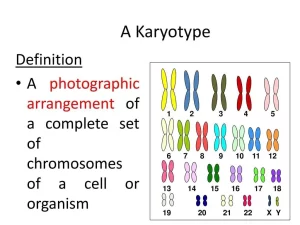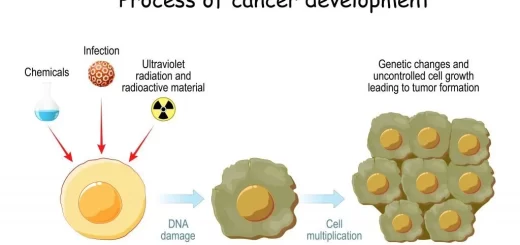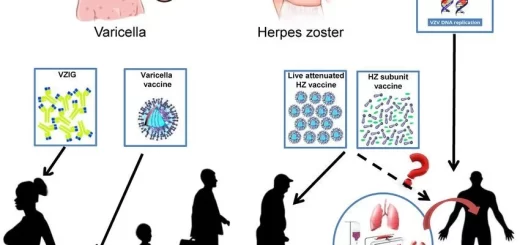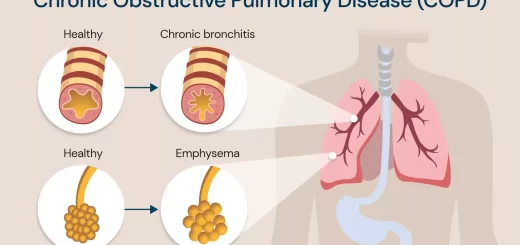Cytogenetics, Practical class of karyotype (Chromosomal Analysis), Karyotype examples with structural abnormalities
Cytogenetics is a branch of genetics, It is a part of cell biology/cytology (It is a subdivision of human anatomy), It is concerned with how the chromosomes relate to cell behaviour, particularly to their behaviour during mitosis and meiosis, Techniques used include karyotyping, analysis of G-banded chromosomes, other cytogenetic banding techniques, as well as molecular cytogenetics such as fluorescence in situ hybridization (FISH) and comparative genomic hybridization (CGH).
Cytogenetics
Cytogenetics: as the term implies, is the branch of medicine that deals with the study of the genetic makeup of a cell (represented by chromosomes analyzed during the metaphase of dividing cells examined by the light microscope.
Demonstration of practical steps involved in karyotype preparation
- A three ml peripheral blood sample is withdrawn and put in a heparinized vacutainer under sterile conditions.
- A few drops (7-10) of whole blood are put in a 10ml prepared culture medium. This step takes place in a strict aseptic condition under the laminar flow hood.
- The culture container (centrifuge tube or tissue culture flask) is then placed in a CO2 incubator at 37°C with 5% CO₂ for 48-72 hours.
- Harvest of cells at metaphase: colcemide is added (to paralyze the mitotic spindle) for 30 minutes.
- Hypotonic solution is then added to help the swelling of the cells to allow the spread of the chromosomes to be better visualized.
- A cold fixative is the last step, using 3:1 methanol glacial acetic acid
- Slide preparation and staining following the addition of Trypsin and stained using Geimsa stain to produce banded karyotype as presented in the karyotype images.
- The chromosomes are arranged according to the size and position of the centromere in Groups from A to G to prepare the karyotype using image analysis software or manually using scissors and glue.
The karyotype
Is the systemic arrangement of the chromosomes of a cell according to their length, centromeric position, and banding pattern. According to the ISCN (international system for cytogenetic nomenclature) [The Standing Committee on Human Cytogenetic Nomenclature in Paris Convention 1978 was adopting a common genetic language as a unified system to describe the different genetic terminology and aberrations].
The longest chromosome being number 1 and the shortest being number 22 followed by the sex partners, XX in females and XY in males. Each normal human cell carries 46 chromosomes (23 pairs, each pair is inherited from one parent); 22 pairs of autosomes and one pair of sex chromosome.
Each chromosome has a primary constriction called the centromere (consists of a constitutive heterochromatin) that divides the chromosome into a long arm termed q and a short arm called p (petit arm). Each arm is divided into regions from the centromere downwards for the long arm and from the centromere upwards for the short arm. Each region contains a number of alternating dark and light bands. More sub-bands are seen with different banding techniques such as high-resolution banding.
Some chromosomes are metacentric i.e. both arms are of nearly equal length (1, 3, 16, 19, 20), others are acrocentric i.e. very short p arm and have satellites that carry no significant genetic material but code for ribosomal RNA and form the satellites (13, 14. 15, 21, 22, Y). The remaining chromosomes are submetacentric i.e. the short arm is about 1/3 the length of the long arm (2, 4, 5, 6-12, 17, 18, X).
Examples of Karyotype with structural abnormalities
t(13:14) is a Robertsonian translocation where both chromosomes are broken at the centromere and they join together at their broken ends of long arms with the loss of their satellites (13:14)(q10:910). The satellites of the acrocentric chromosomes contain a coding sequence of ribosomal RNA so their loss would not cause any chromosomal imbalance due to the presence of many copies on other acrocentric chromosomes.
t(6;9)(p11:q21) describes a reciprocal translocation between chromosome 6 at its short arm region 1 band 1 and chromosome 9 at its long arm region 2 band 1. del(3q13) means a deleted portion of chromosome number 3 at its terminal end of the long arm. The breakpoint is in (q) region 1 band 3.
r(X) indicates a terminal deletion of both arms of chromosome X occurred so that both broken and sticky ends adhere together forming a ring X chromosome. i(Xq) means that chromosome X contains both long arms and missing both short arms yielding a longer chromosome X.
inv(5q11-31) means that a segment of the long arm of chromosome 5 is inverted upside down which is called a paracentric inversion The breakpoints are at long arm chromosome 5 region 1 band 1 and at region 3 band 1.
Inv(7p12-q22) means that a segment of chromosome 7 between region 1 band 2 of its short arm and region 2 band 2 of its long arm is inverted, This is called a pericentric inversion Le the centromere is included in the inverted segment.
47,XX,+21 is a karyotype of a female having an extra chromosome 21 (female Down syndrome). 45,X is a karyotype with a missing chromosome X (X monsomy. Turner syndrome). 47,XXY is a male with an extra X chromosome (Klinefelter syndrome).
Indications of karyotyping
- Premarital genetic counselling for couples before marriage especially if there is a family history of repeated abortions or abnormal live births.
- History of repeated abortions.
- History of previous unexplained repeated intrauterine fetal deaths.
- A child born with multiple congenital malformations.
- Unexplained mental retardation.
- The prenatal diagnosis of one partner is the carrier of a marker chromosome (balanced translocation).
- Unexplained infertility and delayed conception should be undertaken for both partners.
- Cases of sexual ambiguity
- In Cancer to determine non-random chromosomal changes in certain types of tumours (as hematologic malignancies lymphomas and leukemias).
You can subscribe to science online on Youtube from this link: Science Online
You can download Science Online application on Google Play from this link: Science Online Apps on Google Play
Methods of diagnosis of genetic variants, Ethical and social issues related to genetic testing
Genetics variants effects, Types of polymorphisms and disease-causing mutations
Polygenic inheritance vs Single gene inheritance, Non-mendelian inheritance and Genomic imprinting
Chromosomal disorders, structure, classification, and Types of numerical chromosomal abnormalities
Genes, Chromosomes, Proteins, Bacteriophages & Quantity of DNA in the cells
Packaging of DNA, Genome, chromosomal proteins, DNA in Prokaryotes & Eukaryotes




